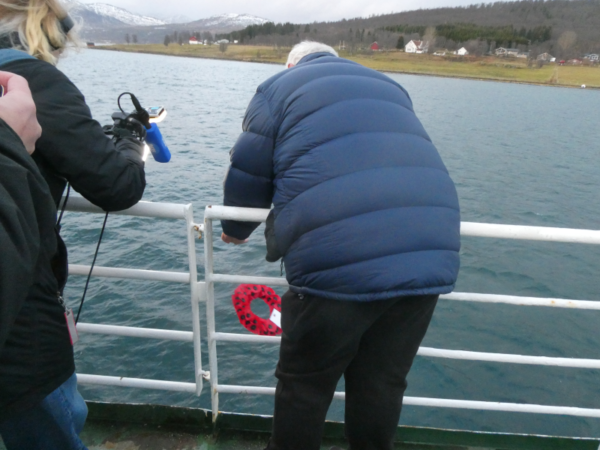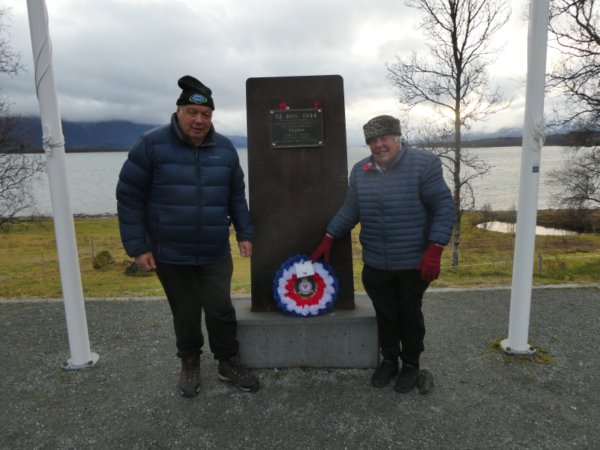News
News
Remembering the Tirpitz crews
Bruce and Alison Hebbard recently travelled to the UK and Norway to join commemorations of the 80th anniversary of the bombing of the German battleship Tirpitz. Their father, Loftus (Lofty) Hebbard was one of the New Zealanders that flew on Operation Catechism, the mission on 12 November which finally resulted in the sinking of Tirpitz.
On the 12th of November they were in Tromso and joined the town’s remembrance to the Tirpitz sinking. Mmany members of the community including the Mayor of Tromso went to the Tirpitz wreck site where Bruce laid a wreath on the water which was recorded by the TV cameras and shown on the local and national TV news. They also travelled to the Tirpitz memorial plate on Hakoy Island and laid another NZBCA wreath there as well.

Caption: Bruce Hebbard lays a wreath at the Tromso commemoration of the Tirpitz raids.
(Credit: Alison Hebbard)

Bruce and Alison Hebbard at the Tirpitz Memorail on Hakoy Island.
(Credit: Alison Hebbard)
This operation is marked each year by the 617 Squadron Association at a dinner held the Petwood Hotel in Woodhall Spa where the Squadron was based in the latter years of WW2. This commemoration is always held on the Saturday night before Remembrance Sunday. Bruce was asked to propose the toast to the crews that took part on this mission.
Tirpitz Toast
I am Bruce Hebbard, son of Loftus Hebbard Bomb Aimer in Authur Joplin’s Crew who took part in the last two operations on Tirpitz in Tromso. I am also President of the New Zealand Bomber Command Association.It is a great honour to propose this toast this evening. It is one that I was asked to propose at the 50th Anniversary 30 years ago in Queenstown New Zealand. On that evening Dad gave an account of the final Tirpitz operation and attending that evening was the NZ Minister of Defence the Hon. Warren Cooper and in his address said ,” Warfare will never be the same again”.
This toast is to the crews that participated in the Tirpitz operations, but we still should bear in mind the other the other members of the Squadron also.
The first of the three operations was the first to Kaa Fjord via Arkangel in Russia and the two to Tromso via Lossiemouth.
For the two Tromso operations the Lancaster aircraft were fitted with the latest mark 14 Merlin Engines with paddle bladed props. To reduce weight the mid upper turret was removed (along with the need of a crew member to operate it) also removed were the guns from the front turret and the ammunition for the rear turret reduced to 400 rounds. The amour plating to protect the back of the Pilot was removed.
To increase the range 200-gallon tank from a Wellington bomber and a 50-gallon tank from a Mosquito were installed inside the fuselage behind the Radio Operator. Petrol fumes permeated throughout the plane during the flight which meant sudden death to all if the tank were to explode when hit.
The details of the operation are well known so I will talk of the particulars of the flight as recalled by my father and his crew being Arthur Joplin, Frank Tilley, Basil Fish, Loftus Hebbard, Gordon Cooke and Bob Yates.
Crews from 617 and 9 Squadrons briefed, at Woodhall Spa, for three hours on the Wednesday afternoon (November 8th) and again on Friday and were told the chances of coming back were slim as two squadrons of German fighters had been shifted to the Tromso area based at Bardafoss. The navigators in particular were given the detailed planed route designed to guide the planes as close as possible to the Tirpitz without being detected.
On Saturday 11th of November, we were out of bed at 7am and later flew to our forward base in Scotland with half the Aircraft at Lossiemouth and the other Miltown. Flying time 2 hours.
Our fuel tanks were topped up and on Saturday evening we were briefed again at Lossiemouth and after our flying meal of bacon, eggs and chips we were summoned to the coaches to take us the ten miles to Milltown. The morning of November the 12th was extremely frosty, and the ground crews were already busy de-icing the wings. Two 9 squadron planes were unable to take off because of severe icing, one being the Commanding Officer of 9 Squadron.
The Lancaster was 10,000lbs overweight and the tyres looked quite flat. The plane hurtled down the runway that terminated at the water’s edge and once the take-off speed of 95 knots was reached the pilot hauled the plane into the air. He commented 50 years later being so overweight it was like flying a wet sponge! Take off was at 3am.
We flew due north until we were near the Shetlands flying at 2000 feet and then turned to fly due east and climbed to 5000 feet to cross the Norwegian coast and into Sweden, where we flew 30 degrees east of north for the full length of Sweden, up the valleys and mountains so as not to be detected by German radar. The dawn lasted about two hours with the mountains and peaks above us; there was no problem because of good visibility.
About 100 miles south of Tromso our navigator said we had reached our assembly point at Akkajaure Lake in Sweden but with the lake iced over and snow all around we started to circle, and it was only when another Lancaster joined us it confirmed we had navigated to the right point. Squadron Leader Tait arrived (his tail fins were distinguished by being painted silver) and continued on his straight course and it was a challenge to leave our circuit and catch up to him and to get into our bombing formation. We came over the mountains about 40 miles to the south and below us was a picture postcard view of the Tirpitz and Tromso. Wind was one knot with no smoke screen, no flak and no fighters.
We had climbed in formation to our various bombing heights of 12000/16200 feet. We came over the mountains about 30 miles south of the ship, travelling at 180 knots. There was no smoke screen and so for the seven-minute bombing run we flew straight and level and we all bombed on the first run. The first wave comprised the seventeen 617 Squadron Aircraft in heights between 12200 feet and 16200 feet. No aircraft was in any other’s slipstream and all were at different heights in five lines over a distance of 1000 yards. A Lancaster takes ten seconds to travel 1000 yards so the last bomb is released within ten seconds of the first. The tallboy travels for approximately 30 seconds and one and a half miles from release from the aircraft until bomb burst.
The flak got intense after we bombed, the Tirpitz main armament had a range of 17 miles and with two flak ships and a repair ship plus shore batteries, we then were given a hot reception. Frank Tilley the flight engineer observed the flak and 15-inch shells slowly rise up (which he described as a fascinating sight) and explode in front of their aircraft and getting closer. He said the German gunners got the altitude absolutely correct but they were just short of their aircraft.
Of the first four bombs dropped two were direct hits.The ship by now was billowing black smoke and steam and further sightings of bomb hits were near impossible although one other bomb recorded a direct hit.
It was later reported that after 5 minutes the ship had a 30-degree list and after a further five minutes the ship had completely rolled over.
The flight engineer in adjusting the throttles for maximum fuel economy found the port outer engine was not responding to the throttle lever and was stuck on plus seven boost. The pilot and engineer decided to feather the port inner and allowed the port outer to do the work for the two.The route homeward flying over the North Sea for 7 hours at 1000 feet was monotonous and tiring.
With fuel getting dangerously low a gap opened up in the clouds showing the Shetland Islands below, so we were able to land at Sumburgh to refuel. It wasn’t as easy as that as there was only a hand pumping facility there and as a minimum load for a Lancaster is 1200 gallons refuelling took some time. The Flight Engineer borrowed a ladder to inspect the port outer engine and found the throttle linkage had been shot off by flak and was able to make temporary repairs. Frank said the WAAF’s bought them out a plate of sandwiches and it was the best food he ever tasted!
The operation taking 14 1/2 hours plus 2 hours between Woodhall Spa Base and Scotland. By the time we debriefed and had a meal we had been 36 hours without sleep.
A history channel commentator said this operation as one of the most outstanding achievements of aerial warfare. A remarkable feat of flying, navigation and precision bombing.
I have proposed many toasts over the last 40 years but none with as a deep personal meaning as this one. In NZ it is normal custom to stand to acknowledge toast. So unless it is more comfortable for you to remain seated, ladies and gentlemen please rise to toast those who we have come to remember tonight.
The crews known as the “Tirpitz Raiders” and those on the ground who supported them.I will finish with this quote made by Walter Stitt an American war veteran from the D-Day commemoration earlier this year on one of the Normandy Beaches in France.
“Many things are worth fighting for, but I wish there was a better way of doing it, than trying to kill each other”
Thank you all
March 10, 2025